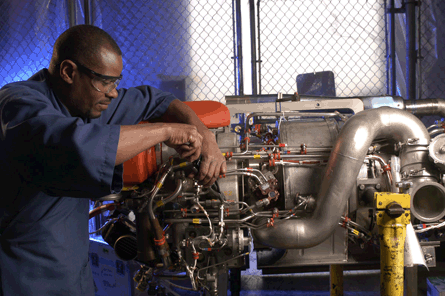Honeywell is seeing increasing demand in the Middle East region for its "power by the hour" product support offerings, driven by growth in the low-fare airline sector and the need for established flag carriers to cut costs.
"The same phenomena are driving the Middle East airlines that are driving airlines everywhere, around the ability to manage their cash and focus on flying customers," says Honeywell vice-president airlines Mike Madsen. "There is interest in the Middle East for certain."
Honeywell's integrated service support offering provides maintenance support and guarantees asset availability for a fixed fee.
"We combine the maintenance for the Honeywell equipment as well as putting assets in the field available for our customers to use on a very rapid-turn basis," says Madsen. "It's particularly attractive to customers in the Middle East because of the distances that they fly, and because of the number of line stations that these carriers serve."
 |
|---|
© Honeywell |
Integrated service support deals were closed with Republic and Air Canada earlier this year, and Madsen says Honeywell is "working with a couple of Middle East carriers on these programmes today".
Savings can be "anywhere from $300,000-600,000 per aircraft in upfront spares, and we estimate $10-12 million per aircraft over the life of the aircraft in savings associated with financing, delays and cancellations and administrative costs," says Madsen. "Low-cost carriers and those carriers that serve a large number of line stations are the ones that we think find it most attractive.
"One of the advantages that we offer is that because we serve many, many airlines, there's an economy of scale that we can take advantage of by positioning the assets in strategic locations to serve more than one airline.
"It's definitely a growing trend, with the financial challenges around the cost of capital that remain for airlines. It will continue to be extremely attractive into the foreseeable future."
Although Middle East airlines have historically been more reluctant to use rotable parts than their European or US counterparts, Madsen says the picture is changing.
"We're operating in challenging economic times, which help people to think differently about things they hadn't thought about in the past," he says.
The Middle East is meanwhile one of the few areas representing a growth opportunity for Honeywell in the commercial aviation sector.
"We're seeing flight hours up about 4%, traffic up about 7% in the region, and a continued high volume of aircraft going into the region," says Madsen. "We're putting more people in the region."
Honeywell Aerospace has used the opportunity to leverage off the support infrastructure already put in place in the Middle East by non-aerospace Honeywell-owned companies.
"We've taken advantage of the fact that we already have a very large presence in the Middle East with other parts of Honeywell, to help us grow quickly there," says Madsen.
UOP, for example, provides catalysts and other services to the refining industry for the production of petroleum products, and the Middle East is one of its biggest markets. UOP is carrying out research into the production of biofuel "molecularly identical" to standard jet fuel. Test flights have been performed with airlines such as Air New Zealand.
"We've got some more announcements coming up later this year on work that we're doing in the Middle East," says Madsen.
Meanwhile, some airlines in the Middle East are looking to develop their own capabilities to repair Honeywell products.
"We see that as a nice advantage for us - it creates a maintenance capability for Honeywell products at a point roughly equidistant between our Singapore operations and our operations in Raunheim."
Madsen is expecting a busy Dubai show, and expects several order announcements.
"You'll probably see some announcements come out at the show around some key wins we've had with Middle East airlines, including our 131-9 auxiliary power unit used on the [Airbus] A320. We're working closely with Saudi Arabian Airlines on an effort that they're pursuing to build capability to repair our APUs.
"You'll see us talking about the fuel efficiency story on the APUs, the benefits of our technologies in weather radar, and then our smart path, smart landing and smart approach products.
"We've taken a number of Middle East flight operations departments up in our test aircraft and shown them the [3D weather radar] system, and they're very excited about it," says Madsen.
Source: Flight Daily News























